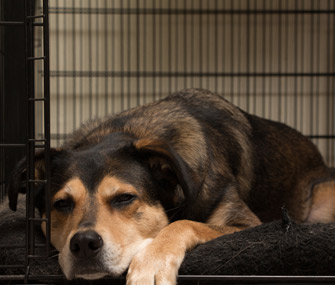
If you were told you needed to be on bed rest for the next few weeks to allow an injury to properly heal, you probably wouldn’t be thrilled, but you’d understand the reason for it — and, most likely, follow your doctor’s orders. After all, bed rest is just an excuse to binge-watch everything on Netflix, right? You might even enjoy being waited on and pampered!
But your dog? That’s a different story. If your pup is injured or undergoes a procedure that requires her to be on crate rest for any period of time (which can often be for weeks on end), she won’t understand why she can’t run around like she usually does. That energy she typically exerts by going on walks or playing with other dogs is going to need an outlet.
Keeping a Crated Canine Happy
Fortunately, there are a few things you can do to help keep your dog happy (or at least somewhat content) while she’s on crate rest.
Internal medicine specialist Dr. Dawn Martin, DVM, DVSc, DACVIM, of Bayside Veterinary Specialists in Tampa, Florida, not only advises her clients on the best care for their dogs after procedures that require crate rest, but also recently went through it herself: Her energetic dog, Ella, underwent a tibial plateau leveling osteotomy for a cranial cruciate ligament rupture, or “the dog version of an ACL,” Dr. Martin says.
It wasn’t always easy to keep Ella calm and still, but it was a good opportunity to practice some of the tips she often gives her clients — and Dr. Martin has agreed to share some of her top tips with us.
Stimulate Your Dog’s Mind Using Food and Toys
“Anytime you take away a dog’s exercise, you have to replace it with some type of stimulation,” Dr. Martin says. “One thing I recommend dog owners do is decrease the amount of food they give the dog as a meal and increase the amount of food they give in a reward-based toy.” Make sure to measure out your dog’s food and check to see that she’s getting her full allotment each day between meals and the treat toy. Dogs who have never used a reward-based toy (or even those who have but just aren’t feeling well after surgery) may find it too difficult to get all their food out of the toy, so it’s important to be certain they’re getting enough to eat, in one form or another.
While every dog is different, they can all benefit from something that helps to occupy their minds. Dr. Martin has seen great success with a wide variety of different reward-based toys — some of which are fairly simple, and others that are far more complex and best suited for exceptionally intelligent and driven dogs. But one of her very favorites is the tried-and-true Kong.
“Stuff the Kong with your dog’s canned food or, depending on any food sensitivities, even some mashed potatoes,” Dr. Martin says. “Then — and this is key — you freeze it.” Your dog will have to spend quite a bit of time and energy getting the frozen goodies out — much more so than if the stuffing was not frozen.
Try Modified Activities (Once Cleared by Your Vet)
Depending on the exact reasons for the mandated crate rest, there also might be a few activities your dog can still do. “You’ll need to get your surgeon involved before doing any of these things,” Dr. Martin cautions, “but once any sutures are removed, you might be able to walk your dog in water, which reduces the amount of weight they’re bearing.”
That doesn’t just mean taking your dog to the beach and letting her go, of course. There are a couple of different options for getting your dog in the water, the first of which would be using an underwater treadmill, which “you should find at any veterinary rehabilitation center,” Dr. Martin says. Your surgeon may be able to recommend a rehabilitation center in your area, and, if the location and cost work for you, your dog might have the opportunity to do things like stair walking and ball exercises in addition to regular walking and swimming — activities your dog will likely find enriching.
If you don’t have a veterinary rehabilitation facility nearby but you do have a pool with stairs, you might be able to incorporate some home water rehabilitation into your dog’s recovery, as long as it’s done safely and under the instruction of your surgeon. You would need to offer your dog support going in and out of the pool, as these are the most likely times for a dog to slip, Dr. Martin says, and make sure she’s outfitted with a flotation device. Then, you can support and guide her as she swims around the shallow end of the pool, always remaining nearby. Even dogs who are normally strong swimmers can have difficulty during recovery, so never assume your pup is fine to take off swimming without your help.
Another great way to provide your dog with some stimulation is to work on command skills to the extent that she’s able. “Again, you’d want to talk to your surgeon to see what [your dog is] allowed to do, but having them sit or stay is great,” Dr. Martin says. “Really, anything that’s reward based and also increases contact time with their human is something that’ll help make the dog happy!”
